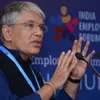India needs bold reforms to kickstart the economy after COVID-19, says economist Paul Alapat
Paul Alapat of Acuity Knowledge Partners strongly believes India can leverage its strengths to turn into a major economic hub for the world, which seemed a distant aspiration until now.
The COVID-19 pandemic has created havoc across the world. The economic impact has been felt the strongest with job losses, salary cuts, and a decline in business, adding to the uncertainty.
Amidst this depressing scenario, there are still rays of hope for a country like India, which is viewed as the last frontier in terms of still being an untapped market, given the size, population, and most importantly, a favourable demographic dividend, with 62 percent of the people still employable.
However, there is still work to be done and reforms that need to be undertaken so that the country can harvest these benefits, if not today but definitely in the near future.
In a conversation with Shradha Sharma, Founder and CEO of , Paul Alapat, Chief Product Officer of Acuity Knowledge Partners, a high value research analytics and business intelligence provider to the financial services sector, shared his views on what needs to be done to revive the economy.
An economist with vast experience of working with leading financial institutions and also a visiting professor at Indian Institute of Management, Bengaluru, Paul says, “This economic contraction is unparalleled and it is the worst since the economic depression of the 1930s.”
Watch the full interview here:
Multiple economic shocks
The prosperity of any nation or society is very much aligned to the gross domestic product (GDP) growth and any deceleration in this number reveals that the economy is not in a good shape.
The current environment has given several economic shocks, be it on the demand or supply side where everybody is suffering, but it is more acute for small and medium businesses and those below the poverty line.
“There is a real danger that the number of people below the poverty line may double, creating a social and economic problem,” says Paul.
This requires deep rooted reforms in the country that need to happen across multiple fronts —regulations, creating infrastructure or equipping the working population with necessary skills.
“One cannot disincentivise entrepreneurs and the messaging has to change, which can make a difference in people’s lives,” he adds.

Paul Alapat, Chief Product Officer of Acuity Knowledge Partners
These include ease of doing business, building infrastructure like roads, power, a flexible land acquisition policy, and most importantly, cutting down on red tape.
This will require the country to play on its strength, which includes its geographic location, human resources talent, and further pushing the participation of women in the workforce.
“We can certainly do a lot more and be more business-friendly. If one is not competitive, then you will not survive the global market,” says Paul.
The key would be to harness the demographic dividend of the country, where little more than 60 percent of the population belongs to the working age group. History has shown that nations have progressed very fast economically when this dividend is in their favour though Paul cautions that there is an urgent need to upskill or reskill the population or we could be sitting on a demographic bomb.
This would mean that there would be large section of the population which is ready to work given their age and education but may not have the required skills which the market demands leading to a situation of high unemployment.
Creating a business-friendly environment
The two big advantages that the country today possesses is the biometric identity platform and single taxation system – Goods and Services Tax (GST). Paul remarks that Aadhaar will help bring large sections of the population residing in the rural and semi urban areas into the formal economy.
Similarly, GST has led to the creation of a single taxation system, which has been evading the country for long, though there are still challenges how this entire structure is implemented.
At the same time, there are favourable winds from the external front that can turn into an advantage for India, especially with regard to China. Paul says, “Every Fortune 500 company with a manufacturing base in China is looking to diversify and they certainly ignore India.”
However, initial reports suggest that other nations like Vietnam, Thailand or Indonesia are able to seize these opportunities and it is not too late for India.
“We have to make India a business-friendly country and create a regulatory environment that is stable,” says Paul.
In this backdrop, the country has laid out an ambitious target of turning into a $5 trillion economy by 2024, but Paul isn’t much concerned about this number as he is about achieving an eight percent GDP growth every year.
“Our plans are good, but in terms of implementation, there is a lot to be desired,” he adds.
We are in an environment, which calls for certain bold and imaginative steps that can help lift the country out of this slow growth momentum and move into a trajectory, which can demonstrate the potential.
“The government needs to jumpstart the economy and the rest will follow,” says Paul.
Edited by Saheli Sen Gupta










